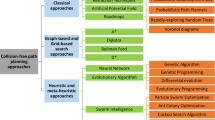Abstract
This paper proposes a synergetic approach to design a planar parallel robot with its control system. In this proposal, the design problem is stated as a dynamic optimization problem with dynamic and static constraints on both the robot parameters and the control input to the robot. Control parameterization via PID controllers is used to rewrite the dynamic optimization problem as a nonlinear programming problem, which is solved by using a hybrid gradient-evolutionary optimization technique. The dynamic optimization problem presents singularity regions in the design space requiring the use of the proposed hybrid gradient-evolutionary optimization technique. The rationale behind the proposed hybrid algorithm lies in using a exploratory search mechanism for finding the initial guess to the fine search mechanism, which is used to search in a local region of a solution. We discuss both the results of the proposed optimization technique and the experimental results of the robot designed with the proposed approach. In addition, the result provided by the proposed synergetic design approach is compared with a sequential design approach, showing the advantages of the synergetic approach.














Similar content being viewed by others
References
Alvarez-Gallegos J, Cruz-Villar CA, Portilla-Flores E (2005) Evolutionary dynamic optimization of a continuously variable transmission for mechanical efficiency maximization, vol 3789. Lecture Notes in Artificial Intelligence Springer, Berlin, pp 1093–1102
Asada H (1983) A geometrical representation of manipulator dynamics and its application to arm design. ASME J Dyn Syst Meas Control 105:131–135
Arnold DV, Salomon R (2007) Evolutionary gradient search revisited. IEEE Trans Evol Comput 11:480–495
Betts JT (2010) Practical methods for optimal control and estimation using nonlinear programming, 2nd edn. SIAM, Philadelphia
Biegler LT (2010) Nonlinear programming: concepts, algorithms, and applications to chemical processes. SIAM, Philadelphia
Bryson-Jr AE (1999) Dynamic optimization. Addison-Wesley, Menlo Park
Cruz-Villar CA, Alvarez-Gallegos J, Villarreal-Cervantes MG (2009) Concurrent redesign of an underactuated robot manipulator. Mechatronics 19:178–183
Deb K, Kain S (2003) Multi-speed gearbox design using multi-objective evolutionary algorithms. ASME J Mech Des 125:609–619
Deb K, Pratap A, Agarwal S, Meyarivan T (2002) A fast and elitist multiobjective genetic algorithm NSGAII. IEEE Trans Evol Comput 6(2):182–197
Fu K, Mills JK (2005) A convex approach solving simultaneous mechanical structure and control system design problems with multiple closed-loop performance specifications. ASME J Dyn Syst Meas Control 127:57–68
Ghorbel FH, Chételat O, Gunawardana R, Longchamp R (2000) Modeling and set point control of closed-chain mechanisms: theory and experiment. IEEE Trans Control Syst Technol 8:801–815
Goldberg DE (1989) Genetic algorithms in search, optimization and machine learning. Addison-Wesley, Mass
Hibbeler RC (2003) Engineering mechanics : statics & dynamics. Prentice-Hall, New Jersey
Liu XJ, Wang J, Pritschow G (2006) Kinematics, singularity and workspace of planar 5r symmetrical parallel mechanisms. Mechanism and machine theory 41:145–169
Ma O, Angeles J (1990) The concept of dynamic isotropy and its applications to inverse kinematics and trajectory planning. In: Proceedings of the IEEE international conference on robotics and automation, pp 481–486
Merlet JP (2001) Parallel robots. Kluwer Academic Publishers, Dordrecht
Messac A, Turner J, Soosaar K (1985) An integrated control and minimum mass structural optimization algorithm for large space structures. In: JPL proceedings of the workshop on identification and control of flexible space structures, vol 2, pp 231–266
Mezura E, Coello-Coello CA (2005) A simple multimembered evolution strategy to solve constrained optimization problems. IEEE Trans Evol Comput 9:1–17
Pil AC, Asada H (1996) Integrated structure/control design of mechatronics systems using a recursive experimental optimization method. IEEE/ASME Trans Mechatron 1:191–203
Price KV, Storn RM, Lampinen JA (2005) Differential evolution: a practical approach to global optimization. Springer, New York
Ravichandran T, Wang D, Heppler G (2006) Simultaneous plant-controller design optimization of a two-link planar manipulator. Mechatronics 16:233–242
Salomon R (1998) Evolutionary algorithms and gradient search: similarities and differences. IEEE Trans Evol Comput 2:45–55
Tao G, Kokotovic PV (1996) Adaptive control of systems with actuator and sensor nonlinearities. Wiley, New York
Ting KL (1986) Five-bar grashof criteria. J Mech Transm Autom Des 108:533–537
Tsai LW (1999) Robot analysis: the mechanics of serial and parallel manipulators. Wiley, New York
Tu Q, Rastegar J (1993) Determination of allowable manipulator link shapes; and task, installation, and obstacle spaces using the monte carlo method. J Mech Des 115:457–461
Villarreal-Cervantes MG, Cruz-Villar CA, Alvarez-Gallegos J, Portilla-Flores EA (2010) Differential evolution techniques for the structure–control design of a five-bar parallel robot. Eng Optim 42:535–565
Yan HS, Yan GJ (2009) Integrated control and mechanism design for the variable input-speed servo four-bar linkages. Mechatronics 19:274–285
Yoshikawa T (1985) Dynamic manipulability of robot manipulators. J Robot Syst 2:113–124
Zhang WJ, Li Q, Guo LS (1999) Integrated design of mechanical structure and control algorithm for a programmable four-bar linkage. IEEE/ASME Trans Mechatron 4:354–362
Acknowledgments
The first author is grateful to Prof. Carlos A. Coello for useful discussions and courses taught. The authors acknowledges support from the National Council for Science and Technology of Mexico (CONACyT) through Grants 182298 and 084060 and the support from “Secretaría de Investigación y Posgrado” (SIP) of the Instituto Politécnico Nacional (IPN) through Grant No. 20131053.
Author information
Authors and Affiliations
Corresponding author
Rights and permissions
About this article
Cite this article
Villarreal-Cervantes, M.G., Cruz-Villar, C.A. & Alvarez-Gallegos, J. Synergetic structure–control design via a hybrid gradient-evolutionary algorithm . Optim Eng 16, 511–539 (2015). https://doi.org/10.1007/s11081-014-9254-x
Received:
Accepted:
Published:
Issue Date:
DOI: https://doi.org/10.1007/s11081-014-9254-x




